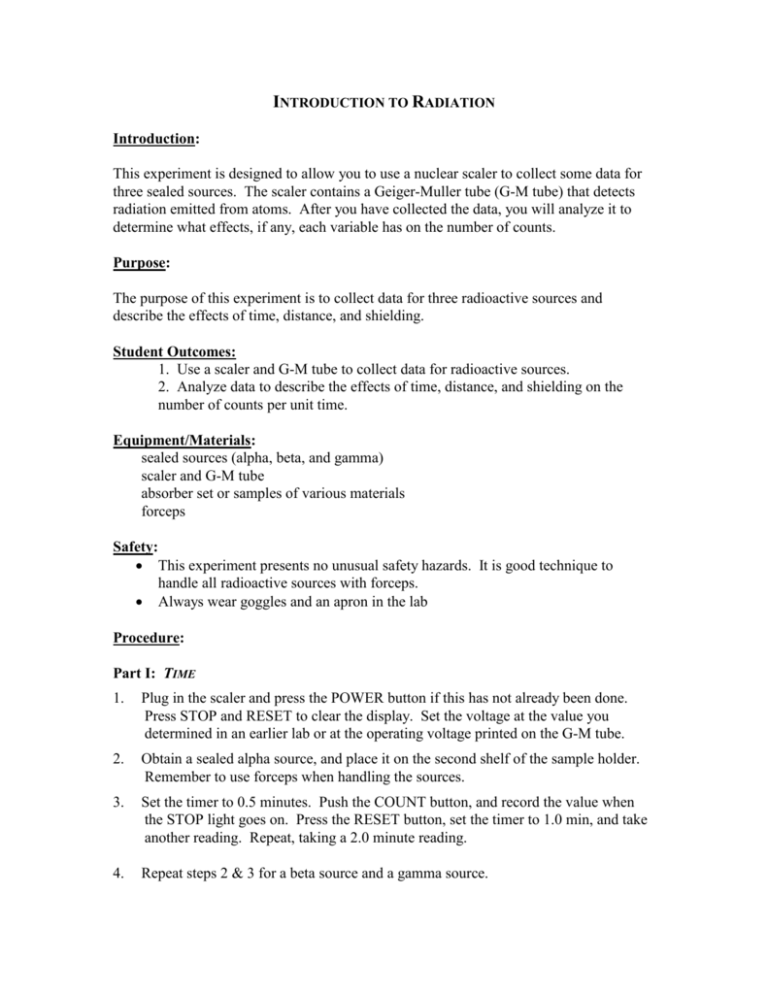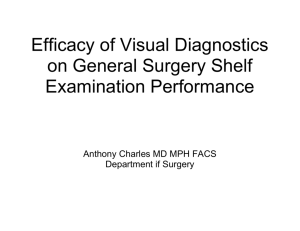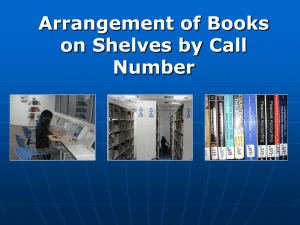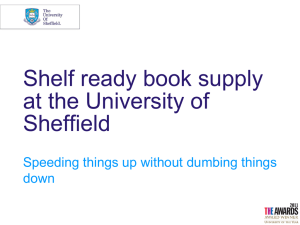INTRODUCTION TO RADIATION
advertisement

INTRODUCTION TO RADIATION Introduction: This experiment is designed to allow you to use a nuclear scaler to collect some data for three sealed sources. The scaler contains a Geiger-Muller tube (G-M tube) that detects radiation emitted from atoms. After you have collected the data, you will analyze it to determine what effects, if any, each variable has on the number of counts. Purpose: The purpose of this experiment is to collect data for three radioactive sources and describe the effects of time, distance, and shielding. Student Outcomes: 1. Use a scaler and G-M tube to collect data for radioactive sources. 2. Analyze data to describe the effects of time, distance, and shielding on the number of counts per unit time. Equipment/Materials: sealed sources (alpha, beta, and gamma) scaler and G-M tube absorber set or samples of various materials forceps Safety: This experiment presents no unusual safety hazards. It is good technique to handle all radioactive sources with forceps. Always wear goggles and an apron in the lab Procedure: Part I: TIME 1. Plug in the scaler and press the POWER button if this has not already been done. Press STOP and RESET to clear the display. Set the voltage at the value you determined in an earlier lab or at the operating voltage printed on the G-M tube. 2. Obtain a sealed alpha source, and place it on the second shelf of the sample holder. Remember to use forceps when handling the sources. 3. Set the timer to 0.5 minutes. Push the COUNT button, and record the value when the STOP light goes on. Press the RESET button, set the timer to 1.0 min, and take another reading. Repeat, taking a 2.0 minute reading. 4. Repeat steps 2 & 3 for a beta source and a gamma source. Part II - DISTANCE 1. Place a sealed alpha source on the top shelf of the sample compartment, and take a one minute reading. Lower the source to the next shelf, and take another one minute reading. Remember to record your data and to reset the scaler between measurements. Continue until readings are taken on all the shelves. 2. Repeat the procedure in Step 1 with the beta and gamma sources. The order in which they are used does not matter. Part III - SHIELDING 1. Take a one minute reading with no sample in the sample compartment. This will serve as the background reading. 2. Place a sealed alpha source on shelf 2. It will remain on this shelf for the entire experiment. Take a one minute reading. 3. Place the index card over the sealed source sample, and take another one minute reading. Repeat the procedure with the other materials indicated on the data sheet. 4. Repeat Step 2 and 3 for the beta and gamma sealed sources. 5. Take another one minute background reading. Data Part I – TIME ALPHA BETA GAMMA ________________________________________ ________________________________________ ________________________________________ 0.5 minute count 1.0 minute count 2.0 minute count Part II - DISTANCE Alpha Source Shelf 1 ____________ Shelf 2 ____________ Shelf 3 ____________ Shelf 4 ____________ Shelf 5 ____________ Shelf 6 ____________ Gamma Source Shelf 1 ____________ Shelf 2 ____________ Shelf 3 ____________ Shelf 4 ____________ Shelf 5 ____________ Shelf 6 ____________ Beta Source Shelf 1 ____________ ____________ ____________ ____________ Shelf 5 ____________ Shelf 6 ____________ Shelf 2 Shelf 3 Shelf 4 Part III - SHIELDING Background Alpha Source Air Paper Al Foil Al Metal Lead Other ______________ _____________ _____________ _____________ _____________ _____________ _____________ Beta Source Air Paper Al Foil Al Metal Lead Other _____________ _____________ _____________ _____________ _____________ _____________ Gamma Source Air Paper Al Foil Al Metal Lead Other _____________ _____________ _____________ _____________ _____________ _____________ _____________ Background Questions: 1. What were the three independent variables studied in this experiment? 2. Describe the relationship you observed between count rate and time in Part I. 3. a. Describe the relationship you observed between distance and count rate in part II. b. What term is used to describe this relationship?. 4. Were there any differences between the sealed sources in Part II? What does this tell you about the ability of different forms of radiation to travel through air? 5. What happened when the distance between the beta source and the detector doubled? 6. How do you know if a shielding material has completely stopped a particular type of radiation? 7. From your data, what substance would be required to stop each of the three types of radiation? Teacher Notes Introduction to Radiation Standards Met: 3.4.12.A – Apply concepts about the structure and properties of matter. Apply the predictability of nuclear decay to estimate the age of materials that contain radioactive isotopes. Explain how radioactive isotopes that are subject to decay can be used to estimate the age of materials. Classify and describe, in equation form, types of chemical and nuclear reactions. 3.7.12.B – Evaluate appropriate instruments and apparatus to accurately measure materials and processes. Apply and evaluate the use of appropriate instruments to accurately measure scientific and technological phenomena within the error limits of the equipment. 3.1.12.C – Assess and apply patterns in science and technology. Assess and apply recurring patterns in natural and technological systems. 3.4.10.A – Explain concepts about the structure and properties of matter. Know that atoms are composed of even smaller sub-atomic structures whose properties are measureable. 3.7.12.A – Apply advance tools, materials and techniques to answer complex questions. Evaluate and use technological resources to solve complex multistep problems. Lab Time: A total of two lab periods is probably required for data collection. The time required can be shortened if counts are taken for a half-minute instead of one minute. The class can also pool their data. Preparations: Time: This lab does not require the preparation of any solutions. You may wish to turn the scalers on so they are warmed up when the students arrive. If absorber kits are not available, any pieces of sheet metal or other materials can be used in their place. Set up time should not take more than 10 minutes. Sample Data/Results: Data Part I - TIME 0.5 minute count 1.0 minute count 2.0 minute count ___251________ ___494________ ___1002_______ Part II - DISTANCE Alpha Source Shelf 1 ____1002______ Shelf 2 _____300______ Shelf 3 ______45______ Shelf 4 ______15______ Shelf 5 ______15______ Shelf 6 ______15______ Beta Source Shelf 1 _2006_______ _1707_______ __998_______ __853_______ Shelf 5 __511_______ Shelf 6 __398_______ Shelf 2 Shelf 3 Shelf 4 Gamma Source Shelf 1 ____3018____ Shelf 2 ____2104____ Shelf 3 ____1523____ Shelf 4 _____747____ Shelf 5 _____364____ Shelf 6 _____203____ Part III - SHIELDING Background Alpha Source Air Paper Al Foil Al Metal Lead Other _________15__ _______1999__ _________16__ _________17__ _________15__ _________16__ _________15__ Beta Source Air Paper Al Foil Al Metal Lead Other ____2000_____ ____2000_____ ____2000_____ ____1000_____ _____100_____ depends on substance Gamma Source Air Paper Al Foil Al Metal Lead Other ____3000_____ ____3000_____ ____3000_____ ____3000_____ ____1600_____ few substances other than lead will reduce count rate significantly _______15____ Background Answers to Questions: 1. Time, distance, and shielding 2. Count rate should increase as time increases (direct relationship). 3. a. Count rate decreased as distance increased b. Inverse relationship 4. Yes. Alpha radiation drops off more quickly as the distance increases. Gamma and beta travel through air more easily than alpha. 5. The count rate should drop to one fourth of the original count rate. 6. The count rate should drop to background. Because of background, the count rate will never drop to zero. 7. Alpha - index card (or air if the distance is great enough) Beta - usually thicker Al or thin Pb Gamma - several inches of lead may be required to completely stop the gamma radiation Evaluation Introduction to Radiation 1. Describe the effect of time on the count rate for a radioactive source. 2. Which radioactive source was most easily affected by changes in distance? What does this tell us about the ability of that type of radiation to travel through air? 3. Which type of radiation required the least amount of shielding to stop it? 4. Is it reasonable to expect the count levels to reach zero when using shielding? Why or why not? 5. Write a brief description which another student could use to measure count rates using a scaler. Answers to the Evaluation: 1. As time increases, the count rate increases. They are directly proportional. 2. Alpha particles are easily absorbed by air. 3. Alpha particles. 4. No, background radiation will always be present. 5. The discussion should include: turning on the equipment, allowing it to warm up, setting the time, recording the values, using the reset button, and taking the next count. Considerations: This lab could also be done utilizing the discovery approach. Ask students to discover what effects time, distance, and shielding have on each type of radiation. Minimal directions (how to set operating voltage and which buttons to push) should be given. This approach may require more time. No special preparation is required for this experiment. If absorber sets are not available, any uniform pieces of material may be used. Sheet metal cut into 2 inch squares would work well. (This is the time to remind the industrial arts teachers that they owe you several favors.) The distance part of this activity can be used as an inverse square activity. When the distance is doubled, the count rate should be cut to one fourth. This works better for beta sources and longer counting times. Last updated 10-02






